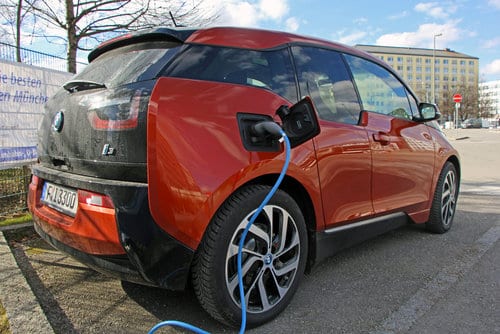Australian governments should “learn from the successes of other countries” and introduce policy incentives to support electric vehicle adoption, a new report from The Australia Institute has recommended.
This would not only align governments with popular voter opinion – 64 per cent of all Australians, as the chart below illustrates – but provide a quick, low-cost way to vastly improve air quality, slash national carbon emissions, and cut household spending on transport.
That is the key message from The Australia Institute’s new report, released this week, titled If you build it, they will charge: Sparking Australia’s electric vehicle boom.
The report, authored by Dan Cass and Matt Grudnoff, reaffirms what we already know: that Australia lags embarrassingly – and inexplicably – far behind the rest of the world in the transition to electric vehicles.
This is illustrated in the chart below, which readers should note represents a comparatively “bumper year” for EV sales in Australia, with total sales actually falling, year-on-year, since 2015.
The global automotive transition – which is well underway in countries like Norway, India, the UK and China, thanks to strong policy levers and clear transport emissions targets – is widely considered to be as inevitable as the current shift from fossil fuel based electricity networks to 100 per cent renewables.
That is because it is part of the global solution to limiting global warming. But as with renewables, electric vehicles are also highly popular among consumers, because they are smart, clean, easier to maintain, and will ultimately cost consumers less, particularly as costs of batteries continue to fall.
The report cites Bloomberg New Energy Finance projections that in some markets electric vehicles will be cheaper than conventional fuel vehicles by 2022, even without subsidies or a global carbon price.
But that doesn’t let Australia’s politicians off the hook.
“Polling shows almost two thirds of people (64 per cent) want government incentives to encourage people to purchase electric cars, including a majority of supporters of all the major parties,” said Grudnoff, who is a TAI senior economist. (See chart below)
“Half of all people agree that people purchasing electric vehicles should pay less tax than those purchasing vehicles that run on petroleum.”
But while data shows that Australian consumers are just as keen as their international peers to embrace electric vehicles, governments appear to have stalled on the grid, failing to use policy to clear the three main barriers to uptake: cost, range anxiety and lack of a decent market.
So what should they do?
The TAI paper recommends four policies to help Australia transition to electric vehicles: Exempt all electric vehicles from Luxury Car Tax; a benchmark for vehicle emissions with penalties paid by vehicles depending on how far above the benchmark they are and subsidies for vehicles depending on how far below the benchmark they are; targeted incentives to encourage the development of EV charging stations in strategic locations; and, for a limited time, to allow electric vehicles to use bus and car pool lanes.
And if adopted, the benefits will go well beyond boosted poll ratings, says the report.
“If governments act now to support the development of the market, financial and environmental benefits will flow,” it says. “Besides saving consumers money, electric vehicles offer great societal benefits: cleaning up air in cities, reducing greenhouse emissions and providing economic stimulus in manufacturing.
But one of the biggest pay-offs would be for Australia’s carbon budget.
“Emissions from vehicles are on the rise and Australia currently has no serious policy measures to curb their growth,” said Grudnoff. “If we have any chance of meeting our Paris targets then the government needs to look at a board range of policies that impact on lots of different sectors.
“Transport is the third largest sector contributing to Australia’s greenhouse gas emissions and there are currently no serious policies to curb these emissions.
According to the report, a fully-electric passenger car fleet would see tailpipe emissions from light vehicles, which produce considerable local pollution and represent 10 per cent of Australia’s
total carbon emissions, fall to zero.
Even in a worst case scenario, the report adds, where EVs used coal-fired power from the grid, this would be less emissions intensive than the average efficient light vehicle.
“All up, with their potential to reduce air pollution in urban areas, curb carbon emissions from electricity and the transport fleet, save consumers money and improve vehicle safety standards, electric vehicles should be an easy sell in Australia,” the report says.










